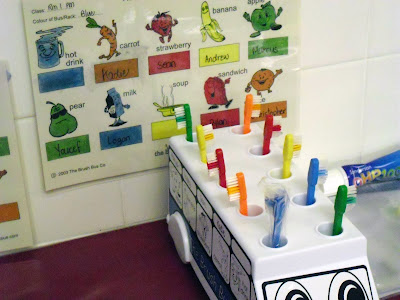source
Ah the dreaded First Week of School when you need to start right back at the beginning. You forget how much work it is to get back into a routine, settle the children into school, and establish "The Rules." My school actually has established
Golden Rules that are to be followed by the whole school, but I still think it's important to discuss your own class rules so everyone knows what the expectations are for the classroom. So how do you go about doing that?
I've seen this done in different ways. Of course, there's the list of "don'ts" that clearly state your aversion to gum chewing and interruptions. Naturally, you want children to know what they aren't allowed to do in class, but in my experience, kids already know the don'ts, and they don't like hearing the word "no." Children respond to positive language. Don't you?
Be Positive.
Keep your "rules" positive. Instead of saying "Don't hit others," simply change that to "Be kind to others." That simple statement covers a multitude of sins (hitting, name-calling, exclusion, etc.), that way you don't need to list every little offense that a child might commit. One teacher I know only has two rules in the class. They are 1.
Show respect (to yourself, to others, to property) and 2.
Do your best (best teamwork, best work, best thinking). I love that the kids only have two things to remember, and the rules are broad enough to cover almost everything.
Include the Children.
This may be old news to most of you, but I still think it's worth talking about. Establishing the rules of the room should be led by the children, not you the teacher. Kids know to put up their hand to talk. They know not to hurt people. They know they need to try their best. They know not to eat the glue (for the most part). They will give you EVERYTHING you want to hear. And if you give them the responsibility to remind YOU and EACH OTHER of what those rules are, they will take that responsibility VERY seriously. What they come up with may need a little narrowing down, and that's where you come in. I don't think it's necessary to put "no picking your nose" on the final copy (or maybe it is?).
Rules.
To be honest, I'm not really a fan of the word "rules." I'd much prefer to go about this task in a more positive manner, telling the children that we are creating a Class Promise or Full Value Contract or Code of Conduct (depending on the age of your class). Despite the age, I think it's important to get the children to "sign" the Promise, even if they are still at the pre-writing stage.
Consequences
I'm a firm believer in natural consequences. I hate the idea of time out (I do believe in taking a break, but I will get to that in a minute). If a child is doing something where they could potentially get hurt (like balancing on blocks), and they eventually fall and get hurt, that is a natural consequence. I wouldn't take them away from the blocks; they would have learned already that balancing on blocks can be dangerous and to be more careful next time.
Let children learn from their mistakes. Side-note: As as adult, I would obviously not let a child take a risk that I felt was dangerous.
Obviously, if a child is hurting someone else, I would take them away from the situation, but not to a time out. In my experience time outs aren't very effective. They are a temporary solution where the adult rarely puts any input into the solving of the problem. Even for 3 year olds, it's important to talk about what happened, remind them of the Class Promise, and relocate them to something or someone different, NOT to a specified "time out". Sometimes kids just need a break from each other. I have a "Breath Box" in my class, if necessary. It's full of things like playdough, stress balls, photographs depicting different emotions, sensory bottles, paper/crayons, bubbles, etc. Sometimes, a child just needs a few minutes to themselves to regroup, breath, and exert some of that emotion on some playdough.
With older children, I would even have a go at having them come up with some consequences. Sometimes, they can be a little more harsh that I would ever be! If they decide on the consequences, they may be even more likely to behave according to the class's Code of Conduct (or Promise, or Full Value Contract...).
Rewards.
I don't want to dwell too much on consequences because I think it's even more important to focus on, and reward those who are doing exactly what they should be. I'm not talking about a Treasure Chest of Poundland rubbish, but about natural or non-tangible rewards. Sounds exciting, right? It can be! A simple, "my you're sitting smartly!" can sometimes be all it takes to motivate a child to continue doing what they're doing (and encourage those around them to as well). Sometimes it can be easy to forget about those children who are always following the "rules" because they aren't being disruptive. Don't forget to
see those kids and recognise that they are fulfilling the Class Promise.
See
Behaviour 101 for some other ideas on how to manage behaviour in your class.
How do you establish "The Rules" in your class?





































